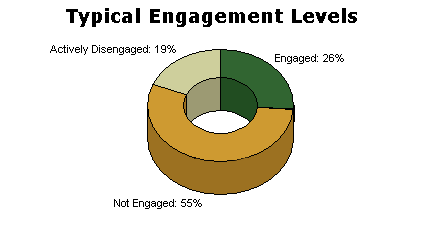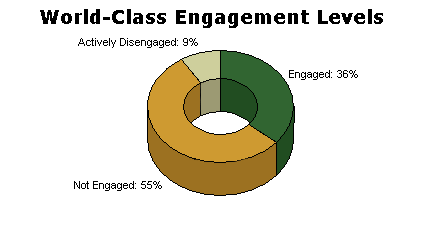Measuring three key factors is just the starting point
Many leading organizations have launched efforts to achieve "world-class sales." But what exactly does it mean to have a world-class sales organization? And have your salespeople achieved that level?
First, "world-class" does not refer to an organization's geographic reach. We are not talking about global sales forces. Rather, we are talking about a set of standards that can be used to measure and compare performance. World-class manufacturers, for example, adhere to a strict set of protocols set by the International Organization for Standardization (ISO) that define best practices ranging from incoming quality inspections to packaging of finished goods. To achieve world-class manufacturing status, companies must measure and improve the various components that make up those standards until they can compete with the world's best.
Similarly, the process of developing a world-class sales organization begins with some simple standards. How good is your sales force? How do you know? How will you know if it's getting better?
Sales revenue alone does not tell the story
For decades serious-minded sales executives managing large organizations understood how difficult it was to answer these very straightforward questions. Bill H., a vice president of sales for an organization with more than 1,000 employees, told us, "I rely an awful lot on my own judgment. Could our sales force be doing a better job? Are we better than our competition? Are we better this year than we were two years ago? These are all questions I'd love to have answers to, but we have very little data to help me answer those questions."
Jim B., a national sales manager for a large manufacturer of medical devices, put it this way: "When sales are up and we are way above budget, we are heroes, but if sales are down for a quarter, we quickly turn into villains. Often the sales force itself isn't any different this quarter than they were last quarter. It's essentially the same people and the same organizational structure. When our company comes out with a better product, our sales force kicks the competition's butts, but when they come out with something better, they do the same to us. Who really has a better sales force? How do we measure that? How do we know if we are getting better?"
Sales revenue is an excellent barometer to measure how well the company is doing, but sales results don't necessarily measure how good the sales force is. Over the years many different financial indexes have been used to track sales performance. Sales per person, earnings per sales person, gross profit per salesperson, etc. -- there is an almost endless list of financial ratios.
When we looked at 11 different sales forces in the same industry and compared these ratios, we found that the ratios told us almost nothing about the quality or caliber of the sales forces. This measurement tended to reflect the company's market share and profitability rather than measuring the sales force's capability.
"Imagine running a manufacturing plant with no data except output and trying to evaluate how efficient the plant is," Pat H. told us. "That's precisely where we stand with our sales force."
As a matter of fact, quite a few people were thinking about those exact problems with respect to manufacturing more than 25 years ago. The result was the inception of total quality management (TQM), which became a key component of world-class manufacturing.
"What drove us to total quality management," said Dave M., a vice president of quality at one of The Gallup Organization's clients, "was the realization that as manufacturers, we were measuring the wrong things. We were measuring output. We were measuring scrap. What we needed to measure instead was incoming components and process control. You don't achieve zero defects by measuring scrap or output. Nonetheless, if the incoming components were defect free and the processes were within parameters, we could deliver a quality product each and every time. Once we understood what it was we had to measure, we then also understood what we needed to do to improve."
At Gallup, we asked ourselves, what are the most important factors to measure when assessing the quality of a sales force? What defines a world-class selling organization? What indexes could we use to compare different sales organizations, and how could we measure improvement? What we found after our research was a matrix of three fundamental elements. They are talent, engagement, and customer loyalty. Those are the critical factors to measure and improve.
Talent
Our extensive research with more than 170 sales forces and 250,000 sales representatives shows that sales is essentially a talent-driven occupation. The way to improve the talent in your sales force is to make sure that the new people you hire have talent configurations that closely match those of the best producers in your existing sales force. This is in contrast to the conventional approach of hiring people with more experience or providing more training to your sales organization.
Beyond a short learning curve, our data show no correlation between experience and sales productivity. Hiring more experienced reps does not improve the sales force. Providing additional sales training also has a limited, short-lived impact. Salespeople in the bottom 50% of most sales forces will not benefit at all from additional training.
Increasing the talent base of your organization, however, does result in substantial improvement. Over the past 30 years, Gallup researchers have identified a way to quantify the talents that characterize your top producers and to measure the talent of incoming sales representatives. We found that talent directly relates to productivity.
Engagement
Engagement is a way to describe and measure the workplace environment in which the sales force must operate. Engagement factors link directly to productivity, profitability, and turnover, as well as other key business indicators. On average, in the sales forces we have studied, only 26% of the sales representatives were engaged in their jobs; 55% were not engaged; and another 19% were actively disengaged.
Training sales managers to pay attention to key engagement factors can produce dramatic improvement in a relatively short time frame. A typical ratio of engaged/not engaged/actively disengaged employees is 26:55:19. In one of the best improvements we have seen, one company improved its ratio to 36:55:9 engaged/not engaged/actively disengaged employees within one year. Our studies also show that a company with a world-class ratio of 36% engaged salespeople to 9% actively disengaged salespeople will vastly outperform a more typical sales force. The 36:55:9 ratio, from our research, marks the beginning of world-class status.
 |
 |
Customer loyalty
The best sales forces we have studied aren't just selling products or services; they are building customer loyalty. Recent Gallup research shows that in industries that rely on their sales force to generate revenue, people are four times more important in building customer loyalty than the products or services themselves are. Customer loyalty is more than a function of customer satisfaction; it incorporates an enthusiasm to purchase the product again and a willingness to recommend it to others. And your sales force is a key factor in generating loyalty and emotional attachment to your company.
Even when markets are down or the economy is slow, the best salespeople are able to create engaged customers. Thus, measuring customer engagement is an important device in evaluating your sales force whether the market conditions are negative or positive.
If your sales force is growing sales, but not adding more loyal customers to your ranks, you'll be in for a big surprise when your competition introduces a product or service similar to yours. In these competitive times, even satisfied customers are more than willing to switch. Loyal customers stick around.
Measurement is just a starting point
One of the myths we encounter frequently is the notion that "measurement improves performance." Measuring the right things is clearly important, and measuring the right things often suggests the appropriate course of action to make genuine improvement. But measurement alone isn't enough. Business would be much simpler if this were true.
Every business organization we know measures sales on a monthly or quarterly basis. Every business measures and reports profits. But not every business sees their sales or their profits rise every quarter. Dieters usually step on a scale every day to weigh themselves. But simply stepping on the scale will not cause you to lose weight. The effort to develop a world-class sales organization cannot start and stop with measurement.
Often when companies commit to recruiting more talented individuals (as opposed to recruiting more experienced individuals), they find they need to look outside their normal recruiting patterns to identify new hires. With a system in place to evaluate talent, managers can spend more time recruiting. They usually become less tolerant of poor performers if they know they can replace them with someone better. Equally important, companies frequently find the need to change some management practices to retain the truly talented people they have working for them already.
Similarly, it's not enough just to measure employee engagement. It's absolutely critical to train supervisors to manage with key engagement factors in mind. Creating the right environment to nourish talented sales reps doesn't happen by accident. With the right training, though, we have seen many organizations improve their employee engagement scores dramatically in a relatively short period of time.
Lastly, focusing on customer loyalty and making it an organizational goal -- one that is just as important as sales or profits -- can substantially improve the likelihood of sustained business growth.
When you're hiring more talented sales reps into your organizational than you're losing, when your fully engaged employees outnumber your actively disengaged employees by a four-to-one ratio, and when your customer engagement scores are at the high end of the range for your particular industry -- then you can then say with certainty that you have developed a world-class sales organization.
Best of all, the costs of operating a world-class organization are far lower and the returns to the bottom line are far higher. In the end, your sales force will become a sustainable competitive advantage for your company, able to compete and win in a leaner and meaner business environment.







